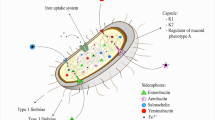Abstract
In Staphylococcus aureus, the intracellular siderophore staphyloferrin B, which has been shown to chelate iron-bound to serum transferrin, is transported into cells by the SirABC system. In this work, we have analysed the role of the Sir transporter under stress conditions that resemble those imposed by the mammalian innate immune system. We show that exposure of S. aureus to oxidative and nitrosative stress generated by hydrogen peroxide and S-nitrosoglutathione, respectively, induced the expression of the sirA gene. The disruption of the sir operon led to a strain with lower viability and decreased resistance to oxidative stress. S. aureus sir null mutant was also analysed during infection of murine macrophages and shown to contribute to S. aureus survival inside macrophages. Altogether, our results indicate that the Sir transport system confers protection against reactive oxygen species, therefore, contributing to the virulence of S. aureus.



Similar content being viewed by others
References
Adler C, Corbalan NS, Seyedsayamdost MR, Pomares MF, de Cristobal RE, Clardy J, Kolter R, Vincent PA (2012) Catecholate siderophores protect bacteria from pyochelin toxicity. PLoS One 7(10):e46754
Ausubel FM (1999) Current protocols in molecular biology. Wiley & Sons, New York
Beasley FC, Marolda CL, Cheung J, Buac S, Heinrichs DE (2011) Staphylococcus aureus transporters Hts, Sir, and Sst capture iron liberated from human transferrin by staphyloferrin A, staphyloferrin B, and catecholamine stress hormones, respectively, and contribute to virulence. Infect Immun 79(6):2345–2355
Chang W, Small DA, Toghrol F, Bentley WE (2006) Global transcriptome analysis of Staphylococcus aureus response to hydrogen peroxide. J Bacteriol 188(4):1648–1659
Cheung J, Beasley FC, Liu S, Lajoie GA, Heinrichs DE (2009) Molecular characterization of staphyloferrin B biosynthesis in Staphylococcus aureus. Mol Microbiol 74(3):594–608
Cotton JL, Tao J, Balibar CJ (2009) Identification and characterization of the Staphylococcus aureus gene cluster coding for staphyloferrin A. Biochemistry 48(5):1025–1035
Dale SE, Sebulsky MT, Heinrichs DE (2004) Involvement of SirABC in iron–siderophore import in Staphylococcus aureus. J Bacteriol 186(24):8356–8362
de Lencastre H, Tomasz A (1994) Reassessment of the number of auxiliary genes essential for expression of high-level methicillin resistance in Staphylococcus aureus. Antimicrob Agents Chemother 38(11):2590–2598
Drechsel H, Freund S, Nicholson G, Haag H, Jung O, Zahner H, Jung G (1993) Purification and chemical characterization of staphyloferrin B, a hydrophilic siderophore from staphylococci. Biometals 6(3):185–192
Friedman DB, Stauff DL, Pishchany G, Whitwell CW, Torres VJ, Skaar EP (2006) Staphylococcus aureus redirects central metabolism to increase iron availability. PLoS Pathog 2(8):e87
Goncalves VL, Nobre LS, Vicente JB, Teixeira M, Saraiva LM (2006) Flavohemoglobin requires microaerophilic conditions for nitrosative protection of Staphylococcus aureus. FEBS Lett 580(7):1817–1821
Grigg JC, Cheung J, Heinrichs DE, Murphy ME (2010) Specificity of Staphyloferrin B recognition by the SirA receptor from Staphylococcus aureus. J Biol Chem 285(45):34579–34588
Grigg JC, Cooper JD, Cheung J, Heinrichs DE, Murphy ME (2010) The Staphylococcus aureus siderophore receptor HtsA undergoes localized conformational changes to enclose staphyloferrin A in an arginine-rich binding pocket. J Biol Chem 285(15):11162–11171
Heinrichs JH, Gatlin LE, Kunsch C, Choi GH, Hanson MS (1999) Identification and characterization of SirA, an iron-regulated protein from Staphylococcus aureus. J Bacteriol 181(5):1436–1443
Livak KJST (2001) Analysis of relative gene expression data using real-time quantitative PCR and the 2(−Delta Delta C(T)) Method. Methods 25(4):401–408
Meiwes J, Fiedler HP, Haag H, Zahner H, Konetschny-Rapp S, Jung G (1990) Isolation and characterization of staphyloferrin A, a compound with siderophore activity from Staphylococcus hyicus DSM 20459. FEMS Microbiol Lett 55(1–2):201–205
Nobre LS, Saraiva LM (2013) Effect of combined oxidative and nitrosative stresses on Staphylococcus aureus transcriptome. Appl Microbiol Biotechnol 97(6):2563–2573
Richardson AR, Dunman PM, Fang FC (2006) The nitrosative stress response of Staphylococcus aureus is required for resistance to innate immunity. Mol Microbiol 61(4):927–939
Ross RA, Onderdonk AB (2000) Production of toxic shock syndrome toxin 1 by Staphylococcus aureus requires both oxygen and carbon dioxide. Infect Immun 68(9):5205–5209
Vliegen I, Jacobs JA, Beuken E, Bruggeman CA, Vink C (2006) Rapid identification of bacteria by real-time amplification and sequencing of the 16S rRNA gene. J Microbiol Methods 66(1):156–164
Yarwood JM, McCormick JK, Schlievert PM (2001) Identification of a novel two-component regulatory system that acts in global regulation of virulence factors of Staphylococcus aureus. J Bacteriol 183(4):1113–1123
Acknowledgments
The work was funded by Fundação para a Ciência e Tecnologia Project Grants PEst-OE/EQB/LA0004/2011, PTDC/BBB-BQB/0937/2012 and the fellowship SRFH/BPD/69325/2010 (LN).
Author information
Authors and Affiliations
Corresponding author
Electronic supplementary material
Below is the link to the electronic supplementary material.
Rights and permissions
About this article
Cite this article
Nobre, L.S., Saraiva, L.M. Role of the Siderophore Transporter SirABC in the Staphylococcus aureus Resistance to Oxidative Stress. Curr Microbiol 69, 164–168 (2014). https://doi.org/10.1007/s00284-014-0567-y
Received:
Accepted:
Published:
Issue Date:
DOI: https://doi.org/10.1007/s00284-014-0567-y




